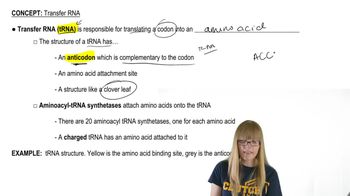To carry out its role, each transfer RNA requires at least four specific recognition sites that must be inherent in its tertiary structure. What are they?
Table of contents
- 1. Introduction to Genetics51m
- 2. Mendel's Laws of Inheritance3h 37m
- 3. Extensions to Mendelian Inheritance2h 41m
- 4. Genetic Mapping and Linkage2h 28m
- 5. Genetics of Bacteria and Viruses1h 21m
- 6. Chromosomal Variation1h 48m
- 7. DNA and Chromosome Structure56m
- 8. DNA Replication1h 10m
- 9. Mitosis and Meiosis1h 34m
- 10. Transcription1h 0m
- 11. Translation58m
- 12. Gene Regulation in Prokaryotes1h 19m
- 13. Gene Regulation in Eukaryotes44m
- 14. Genetic Control of Development44m
- 15. Genomes and Genomics1h 50m
- 16. Transposable Elements47m
- 17. Mutation, Repair, and Recombination1h 6m
- 18. Molecular Genetic Tools19m
- 19. Cancer Genetics29m
- 20. Quantitative Genetics1h 26m
- 21. Population Genetics50m
- 22. Evolutionary Genetics29m
11. Translation
Transfer RNA
Problem 11a
Textbook Question
Consider translation of the following mRNA sequence:
5′-...AUGCAGAUCCAUGCCUAUUGA...-3′
Diagram translation at the moment the fourth amino acid is added to the polypeptide chain. Show the ribosome; label its A, P, and E sites; show its direction of movement; and indicate the position and anticodon triplet sequence of tRNAs that are currently interacting with mRNA codons.
 Verified step by step guidance
Verified step by step guidance1
Identify the start codon (AUG) in the given mRNA sequence. This is where translation begins, and it codes for methionine (Met). The ribosome assembles at this site, and the first tRNA carrying methionine binds to the P site of the ribosome.
Determine the codons in the mRNA sequence following the start codon. Divide the sequence into triplets (codons) starting from AUG. For example, the sequence after AUG is CAG, AUC, CAU, GCC, etc. Each codon corresponds to a specific amino acid.
Focus on the fourth amino acid being added to the polypeptide chain. To determine this, identify the fourth codon in the sequence after the start codon. The ribosome moves along the mRNA in the 5′ to 3′ direction, adding amino acids to the growing polypeptide chain.
Diagram the ribosome at the moment the fourth amino acid is being added. Label the A (aminoacyl), P (peptidyl), and E (exit) sites. The tRNA carrying the fourth amino acid will be in the A site, the tRNA carrying the third amino acid will be in the P site, and the tRNA that delivered the second amino acid will be exiting from the E site.
Indicate the anticodon triplet sequence of the tRNAs interacting with the mRNA codons. The anticodon is complementary to the mRNA codon and is found on the tRNA. For example, if the mRNA codon in the A site is GCC, the anticodon on the tRNA will be CGG. Similarly, determine the anticodons for the tRNAs in the P and E sites.
 Verified video answer for a similar problem:
Verified video answer for a similar problem:This video solution was recommended by our tutors as helpful for the problem above
Video duration:
59sPlay a video:
Was this helpful?
Key Concepts
Here are the essential concepts you must grasp in order to answer the question correctly.
Translation Process
Translation is the process by which ribosomes synthesize proteins using mRNA as a template. It involves decoding the mRNA sequence into a polypeptide chain, where each set of three nucleotides (codon) corresponds to a specific amino acid. The process occurs in three stages: initiation, elongation, and termination, with the ribosome facilitating the assembly of amino acids into a protein.
Recommended video:
Guided course

mRNA Processing
Ribosome Structure and Function
The ribosome is a complex molecular machine composed of ribosomal RNA (rRNA) and proteins, crucial for protein synthesis. It has three binding sites: the A (aminoacyl) site, where new tRNA molecules enter; the P (peptidyl) site, where the growing polypeptide chain is held; and the E (exit) site, where empty tRNAs leave the ribosome. Understanding the ribosome's structure is essential for visualizing how translation occurs.
Recommended video:
Guided course

Ribosome Structure
tRNA and Anticodon Interaction
Transfer RNA (tRNA) molecules are responsible for bringing amino acids to the ribosome during translation. Each tRNA has an anticodon region that is complementary to a specific mRNA codon, ensuring the correct amino acid is added to the growing polypeptide chain. The interaction between tRNA anticodons and mRNA codons is critical for maintaining the accuracy of protein synthesis.
Recommended video:
Related Videos
Related Practice
Textbook Question
352
views



